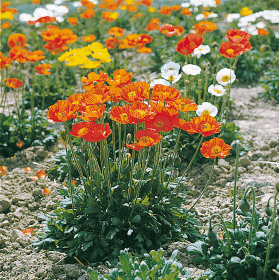
- Sturdy medium size mixture
- Large flower size, abundant flower colors
- Blue green leaf, wintergreen
Culture guide
Usage
Perennial for border and cottage garden, attractive plants for bees, container plants, cut flower production
Sow time
Indoor forcing: January-July, for flowering in pots; Indoor forcing: July-August for flowering in the following year; Indoor forcing: October-July for cut flower production; Outdoor forcing: End April-June for cut flower production
Sowing method
3-5 seeds per plug, tap root formation, sowing directly into final pots or field is recommended
Germination
Germinates in 14-20 days at 60-68 °F (15-20 °C). Light is required for germination.
Growing on
Transplant plugs after 8 weeks. Grow on at 50-60 °F (10-15 °C). Plants prefer cooler growing conditions. Vernalization is not required for flower initiation.
Media
Use a well-drained, growing substrate with 15-30 % clay, 10-15 % parts (e. g. bark, perlite, sand), 1-2 kg/m³ complete balanced fertilizer, 0-2 kg/m³ slow release fertilizer (3-6 months), iron-chelate, micronutrients, pH: 5.5-7.0. Field: loamy sandy humus soils with a good drainage. Standard fertilization: 40-60 g/m² of a slow release fertilizer.
Temperature
Grow at 12-18 °C. Avoid temperatures above 25 °C. In winter indoors frost free at 3-5 °C or outdoors. Outdoors fleece cover needed. In spring the plants start to grow for 8-9 weeks at 13-15 °C and long day. If cultivated at high temperatures, the light intensity should be high for good plant quality. Cold temperatures at 5-10 °C will increase the cultivation time by 2-4 weeks. A chilling period for flower initiation is not required.
Fertilization
Low-moderate fertilization levels are required. Fertilize the crop weekly with 80-100 ppm nitrogen (at 2 kg/m³ slow release fertilizer in substrate), using a complete balanced fertilizer. Don’t fertilize after mid September. In spring fertilize with 100-150 ppm nitrogen of a potassium balanced fertilizer (N: K₂O-ratio: 1:1,5). Avoid high ammonium and high nitrogen levels. High nitrogen levels are the cause that the stems and the foliage are stretched and the plant fall apart. When the buds are visible, additional foliage fertilizations should be carried out. Prevent magnesium deficiency by applying magnesium sulphate (0,05 %) 1-2 times and in case of iron deficiency apply iron-chelate for 1-2 times.
Stage I Starts with the radicle breaking through the testa. The roots are touching the medium. Ends with fully developed cotyledons.
Stage II Starts from fully developed cotyledons. Ends with the fully developed true leaf or true leaf pair.
Stage III Starts from the fully developed true leaf or true leaf pair and ends with 80% of the young plants being marketable.
Stage IV All young plants are ready for sale and in the process of being hardened off. This stage lasts about 7 days.
The cultural recommendations are based on results from trials conducted under Central European conditions. Different conditions in other parts of the world may lead to deviations in results achieved.
